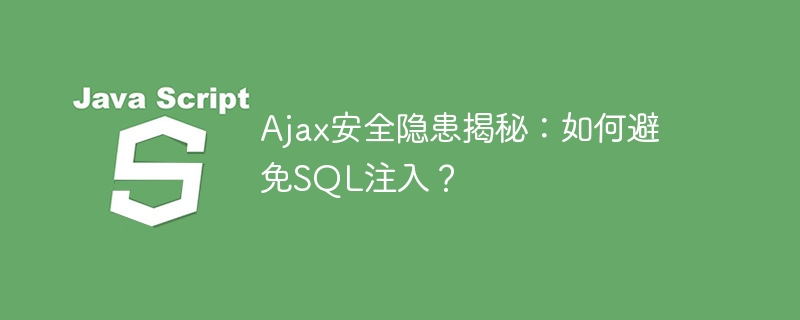

Ajax security risks revealed: How to avoid SQL injection?
With the rapid development of the Internet, Web applications are becoming more and more functional and interactive. The emergence of Ajax technology has greatly improved user experience. However, Ajax technology also brings some security risks, the most common of which is SQL injection.
What is SQL injection?
SQL injection is an attack method that uses a web application to maliciously inject SQL queries issued by the database. Attackers insert malicious code into input boxes or URL parameters, causing the application to submit these codes to the database for execution. Once the injection is successful, the attacker can execute malicious SQL commands to obtain, modify or delete data in the database.
How to avoid SQL injection?
Using parameter binding can effectively prevent SQL injection attacks. Parameter binding works by binding user input directly to placeholders in the SQL query, rather than splicing user input into an SQL string. The following is an example of using parameter binding:
var sql = "SELECT * FROM users WHERE username = ? AND password = ?";
// 假设username和password是用户输入的值
var params = [username, password];
db.query(sql, params, function(result) {
// 处理查询结果
});Parameter binding will escape the value entered by the user to ensure that the user input will not be executed as SQL code.
In addition to using parameter binding, user input should also be verified and filtered. Verify the legality of user input, ensuring that the input data type meets the requirements, the length meets the requirements, etc. Filter user input to remove special characters such as quotes, slashes, etc. Here is an example of input validation and filtering:
var username = validateInput(input.username); // 验证用户名的合法性
var password = filterInput(input.password); // 过滤密码中的特殊字符
var sql = "SELECT * FROM users WHERE username = '" + username + "' AND password = '" + password + "'";
db.query(sql, function(result) {
// 处理查询结果
});Input validation and filtering can reduce the success rate of attackers by injecting malicious code.
In addition to the above measures, permission control should also be strengthened. Ensure that different users can only access data to which they have permission. At the database level, use different user accounts to set different permissions to restrict their operations on the database. At the application level, user operations are strictly controlled based on their roles and permissions.
Summary:
SQL injection is a common and serious security risk. The risk can be reduced by using parameter binding, input verification and filtering, and strengthening permission control. Developers should always pay attention to the security of applications, update and fix security vulnerabilities in a timely manner, and ensure the security of user data and privacy. Only on the basis of security guarantee can we provide users with a better web application experience.
Reference materials:
The above is the detailed content of Revealing Ajax security vulnerabilities and ways to prevent SQL injection. For more information, please follow other related articles on the PHP Chinese website!




